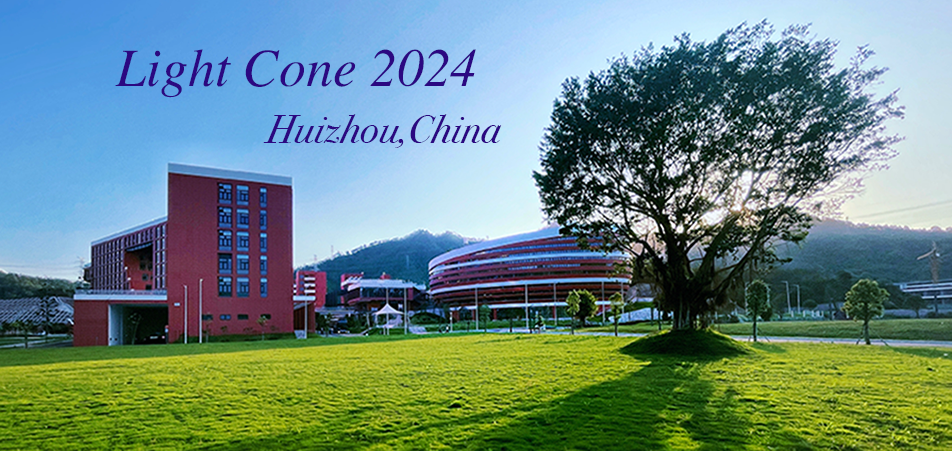The light cone distribution of light mesons, encompassing both one-dimensional light cone distribution amplitudes (LCDAs) and three-dimensional transverse momentum dependent wave functions (TMDWFs), provides insight into the inner structure of hadrons. These distributions are crucial inputs for perturbative calculations in hard exclusive processes. In this talk, I will present recent...
We develop an new approach for calculating heavy quark effective theory (HQET) light-cone distribution amplitudes (LCDAs) by employing a sequential effective theory methodology. The theoretical foundation of the framework is established, elucidating how the quasi distribution amplitudes (quasi DAs) with three scales can be utilized to compute HQET LCDAs. We provide theoretical support for...
As the simplest quark-antiquark systems, pions and kaons are pseudo Nambu-Goldstone bosons closely related to the spontaneous symmetry breaking of the strong interaction. The study of their form factors and parton distribution functions is not only key to understanding their internal structures, but also tied to the mechanism of Emergent Hadron Mass, one of the mass generation mechanisms in...
As Fermi had realized 100 years ago (in 1924), the electromagnetic field inspired by fast moving charged particles can be treated as photon flux, i.e, equivalent photon approximation (EPA). The EPA photons are linearly polarized, which can be used to probe the nucleus 3D structure. We studied the azimuthal asymmetries induced by the linearly polarized photons in exclusive $\rho^0$ and...
We present an innovative approach to the linearly polarized gluons confined inside the unpolarized nucleon in lepton-nucleon scattering. Our method analyzes the correlation of energy flows at azimuthal separations $\phi$.
The interference of the spinning gluon with both positive and negative helicities translates into a $\cos(2\phi)$ asymmetry imprinted on the detector. Unlike the...
The presence of ultra-strong electromagnetic (EM) fields can give rise to various important phenomena in heavy ion collisions (HIC). During the early stages of HI collisions an ultra-strong EM field ($B \approx 10^{18}$ Gauss) is expected to be generated, which can have profound implications for QCD phase transitions as well as chiral symmetry restoration. The charge-dependent directed flow...
Though the quark distributions are are studied in different models, the gluon distributions inside the proton are not studied extensively. To understand the three dimensional structure of proton and the spin and angular momentum contributions of different partons, it is important to evaluate the gluon GPDs and TMDs. We will define a simple spectator model to study the gluon distributions in...
Glueballs are colorless bound states of gluons as they have self-couplings. The existence of glueballs are very distinctive predictions of QCD. In this talk, I will briefly review recent experimental and theoretical progresses on the researches of glueballs. Especially, I will introduce the latest QCD sum rule calculations of the mass spectroscopy for the two-gluon and three-gluon glueballs.
We investigate different decompositions of angular momentum in QCD for a relativistic spin 1/2 composite state, specifically a quark dressed with a gluon. We employ light-front Hamiltonian perturbation theory developed in the light-front gauge and utilize a two-component framework that eliminates constrained degrees of freedom. Our investigation extends to various decompositions of angular...
We compute the gravitational form factors (GFFs) and study their applications for the description of the mechanical properties such as the pressure, shear force distributions, and the mechanical radius of the proton from its light-front wave functions (LFWFs) based on basis light-front quantization (BLFQ). We find acceptable agreement between our BLFQ computations and the lattice QCD for the...
We investigate the internal stress of charmonium using the recently derived light-front wave function representation. We employ three “good components” of the energy-momentum tensor, $T^{++}$, $T^{+-}$, and $T^{12}$, to extract the gravitational form factors. The obtained form factors satisfy the known constraints and are used to derive the physical distributions of the system. We discover...
We investigate the gravitational form factors of a strongly coupled scalar theory in the light-front Hamiltonian approach. The theory can be used to mimic the interaction between the nucleon and the pion. We renormalize the energy-momentum tensor with a Fock sector-dependent scheme. We futher analyze the hadron matrix elements of the energy-momentum tensor and identify three “good currents” to...
Within Basis light-front Quantization framework, we obtain the masses comparable to experiment and the light-front wave functions of $\Lambda_b$ and its isospin triplet baryons $\Sigma_b^+$, $\Sigma_b^0$ and $\Sigma_b^-$. Our prediction of their electromagnetic properties is in agreement with other theoretical calculations. Meanwhile their parton distribution functions (PDFs) are obtained...
Within the basis light-front quantization framework, we systematically investigate the unpolarized and longitudinally polarized double parton distributions (DPDs) of quarks inside the proton. We utilize the light-front wave functions of the proton derived in the valence sector from a Hamiltonian quantized on the light-front. Our current analysis yields significant correlations of the quarks'...
We demonstrate, in the context of a scalar version of the chiral effective field theory, that the multi-sea quark contribution to the nucleon is significant and highly non-trivial in sharp contrast to the prediction of perturbation theory. The non-perturbative calculation is performed in the Fock sector dependent renormalization scheme on the light front, in which the non-perturbative...
We study the spatial distributions of the energy-momentum tensor (EMT) for transversely polarized nucleons in the elastic frame (EF), a general reference frame that bridges the Breit frame (rest frame) and the infinite momentum frame (IMF). As the longitudinal momentum, $P_{z}$, increases, the spin-dependent contributions are induced in the EF energy and EF longitudinal normal force...
We analyze the contributions to the gravitational form factors (GFFs) arising from the photon component of the energy-momentum tensor within the framework of light-front QED. Considering a dressed electron state, we employ the light-front Hamiltonian approach in light-front gauge. Additionally, we explore the impact of the photon on the mechanical properties of the dressed electron state, like...

